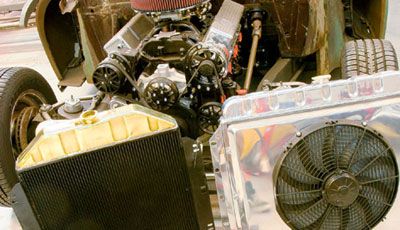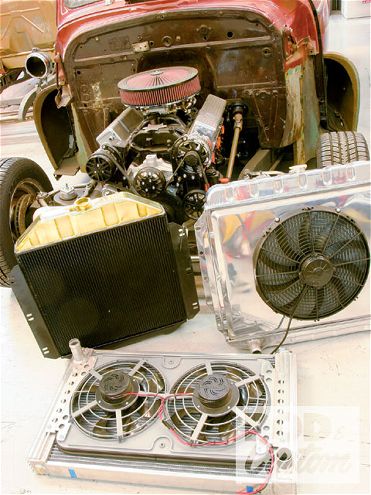

There are a number of things we seem to put up with in our pursuit of driving cool-looking cars. A ridiculously low car will induce a newfound fear of driveways and speed bumps for instance, or suffering lack of steering lock to avoid scrubbing tires against fenders, but sitting at the side of the road when your radiator has just spewed its contents because your cooling system is not up to the job at hand will very definitely not leave you looking cool. In fact it'll do just the opposite!
But for some reason most of us don't consider the radiator early enough in a project, which is crazy when you think how small most hot rod or custom engine compartments are, how we fill them with engines several times larger, both in physical size and capacity, than the original engine, and how they'll undoubtedly generate way more heat than the original. Yet we'll often reduce the number of ways for that heat to escape the confines of the bodywork. Smooth hood sides or inner fender panels, lower ride height and less space under the hood because we've added any number of air space-robbing components all contribute to a reduction in the ability for hot air to escape.
Of course we're focused on installing that new motor or front suspension, or whatever the UPS truck has just delivered, but early in any project we should be considering the radiator and planning for what's required to cool the combination we've just spent a fortune on, rather than leaving it until later and looking for a radiator that will fill the space that's left between the water pump and the backside of the grille. Because we can guarantee that space will not be sufficient in most instances, and that's asking for trouble down the road. Seeing as we mentioned grilles-ensure enough air can pass through the opening. We're not just talking customs here, which often have grille openings smaller than before any bodywork was performed, but hot rods too, such as track noses, sectioned grille shells, or semi-filled openings.
Though it's the radiator that you immediately think of when it comes to cooling, the cooling system consists of more than that one component. Coolant leaves the radiator, enters the water pump and is pushed through the engine, absorbing heat from the block, before passing through the thermostat, whose job it is to maintain the engine at a constant temperature, and back to the radiator, where that heat is dissipated as the coolant passes through it.
Old-style radiators that have the radiator cap on the high pressure side of the radiator, and thus subject to pressure from the water pump, would often expel coolant when the pressure at high rpm would overcome the cap's pressure rating, leading to the misconception that if coolant flowed too quickly through the radiator it would not have time to dissipate heat. But the system is a closed loop, meaning in that instance it would also travel through the engine too quickly, and therefore would not absorb as much heat either. Modern radiators place the cap on the low pressure side of the radiator where it is not subject to water pump pressure, thus benefitting from higher coolant flow.
There are two main aspects to consider when it comes to radiators-airflow through them and surface area. Ideally you want as much of both as possible, which is why planning for as large a radiator as possible at the early stages of a project is important. At the very least you will require a radiator that is the same as, and preferably larger than, the original radiator for your chosen engine, not the vehicle it's now in. So don't go expecting your original '53 Chevy radiator, which previously cooled a straight six, to be up to the task of handling that small-block 350 you dropped in there. Also, bear in mind that higher compression motors make more heat and need more cooling capability.
So what are your choices when it comes to radiators, apart from its size? One of the main choices is whether to go for aluminum or copper and brass. Copper is a better heat conductor than aluminum, and was the mainstay of radiator construction for the majority of our cars when they were new. It's also easier to repair than aluminum, though the latter is cheaper and weighs less. Though the majority of aftermarket radiators are constructed from aluminum, copper/brass versions are still available from companies like Walker Radiator and Brassworks, ideal looks-wise if you're building a traditional style rod without a hood. Advocates of each construction material will defend their choice, but selecting the correct design for your application is more critical than what it's made from!
Then there's the subject of how many rows of tubes your radiator core should have, though a radiator with a larger surface area will cool the water more quickly than a smaller, thicker core in the same situation, maximizing airflow through the latter will help matters. Of course you may not have an option to use a physically larger radiator. The luxury afforded those building cars with full width grilles that can accept a modern style crossflow radiator is lost on the owner of a Model A, or similar, as they have a certain size grille shell that the radiator has to fit in, which is where thicker cores with more rows of cooling tubes come in. Optimizing the airflow through that core is the secret to staying cool, which is where we come to fans.
If your car overheats or gets very hot in traffic or while cruising fairgrounds, but is fine out on the highway, you probably don't have a cooling problem, but an airflow problem. You're simply not getting enough air passing through the radiator and likely not able to let hot air escape from the engine compartment either. Engine-driven fans are great at their job, but when the motor is idling, the fan simply isn't turning fast enough to keep the radiator cool. Options here include an improved mechanical fan, electric fan or fans, or a combination of both.
If a mechanical fan is your choice, the options are a flex fan, which are noisy and rob horsepower, a temperature-controlled viscous fan, the speed of which increases as the temperature of the coolant increases, or a thermostatic viscous fan, which switches on or off at a specified temperature, only running when needed. If you chose to go for an electric fan, it should ideally cover 70 percent of the radiator core, usually meaning two fans will be required. There's also the option of push or pull fans. There's almost always more room in front of a radiator to fit a fan, where a "push" type can be installed, but pulling is more efficient, plus a fan on the front of the radiator in an early car isn't visually appealing, and will itself block airflow.
It's probably rarely considered, but fans not only pull or push air, but also move it radially as they spin. A shroud will ensure the air is all drawn through the fan. Shrouds also enlarge the air draw area, and even shield the radiator from engine heat to a certain extent. Shrouds will work for both electrical and mechanical fans, but if used with the latter, ensure the fan blades are placed halfway into the shroud opening for maximum efficiency and to prevent air escaping, with no more than 1-inch clearance between the tips of the blades and the shroud. You can choose to manually switch on an electric fan, or wire it so it runs all the time the ignition is on, but that's a little pointless when you can get sensors that will either turn the fan on at a specified temperature, or others like Flex-a-lite's Variable Speed Control that set the fan speed from 60 percent to 100 percent depending on the built-in fan thermostat setting, offering greater control over the engine's temperature.
The ideal operating temperature varies depending on who you speak to, but is generally in the 190-210 degree F range, though modern engines are designed to run even hotter, with some not turning their fans on until above 200 degrees.
It is the thermostat's job to maintain a constant temperature in the engine, as well as to allow the engine to heat up to its operating temperature as quickly as possible. It does this by regulating the amount of water that passes through the radiator. Until operating temperature is reached, the thermostat remains closed, re-circulating coolant through the engine. Depending on the thermostat's setting, it will open somewhere between 180 and 195 degrees F, though high-flow thermostats are available that open at 160 degrees F. The coolant will now pass through the radiator at a rate depending on how far the thermostat is open.
These days more than plain water is required in a cooling system, as aluminum (think radiator, heads and intake manifolds) can be damaged without an anti-corrosion additive. Commonly referred to as anti-freeze, ethylene glycol in a 50/50 mix with water will prevent corrosion, lower the freezing point and raise the atmospheric boiling point to around 220 degrees F from 212 degrees F. However, coolant temperatures can reach over 250 degrees F at times, and would therefore still boil, so the cooling system is pressurized to further raise the boiling point. For every pound of pressure the boiling point of water will rise by 3 degrees. Most cooling systems have a pressure limit of 15 psi, and it is the radiator cap that creates the pressure. As the coolant heats, it builds pressure, and the cap is a pressure release valve in essence, as it is the only part of the system where that pressure can escape. When the pressure reaches 15 psi, or whatever the cap is rated at, the valve opens and coolant escapes, usually flowing through the overflow tube to an overflow, or recovery, tank. This keeps air out of the system, and when the coolant temperature drops, a vacuum is created which opens another valve and allows the coolant to return to the radiator from the overflow tank. Which is why a recovery tank is a vast improvement over the overflow tube venting on to the floor! While we're on the subject of keeping air out of the system, it's worth mentioning that the radiator cap should be the highest part of the cooling system, to prevent air pockets.
The only part of the cooling system we haven't talked about is the water pump. Usually, or at least if your radiator is correctly sized and you have the correct thermostat installed, an OE water pump will be adequate, but Edelbrock and Stewart offer high-flow water pumps, with the latter offering four stages for Ford, Chevy and Chrysler applications. The most extreme is capable of pumping 160 gallons-per-minute. The water pump speed should match the crankshaft speed, though by a careful selection of pulleys it can be driven faster than the crank, though any more than 10 percent faster isn't recommended.
If you are having cooling issues, hopefully some of the above may be of use, though of course it is assumed that your engine is tuned correctly and running perfectly to begin with. Apart from the stress induced by a car that runs hot, you risk holed pistons, damaged rings, blown head gaskets, warped heads, premature failure of other components owing to excessive heat, and even a seized motor. It may not be as glamorous or exciting as some other aspects of building a car, but a cooling system that works correctly makes for great peace of mind and increased confidence in your rod or custom's usability.